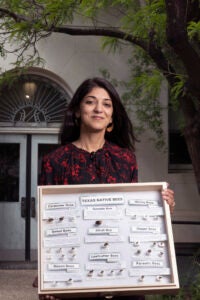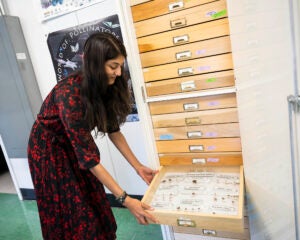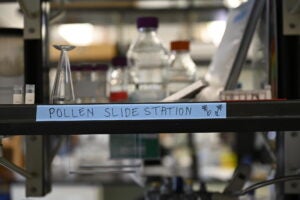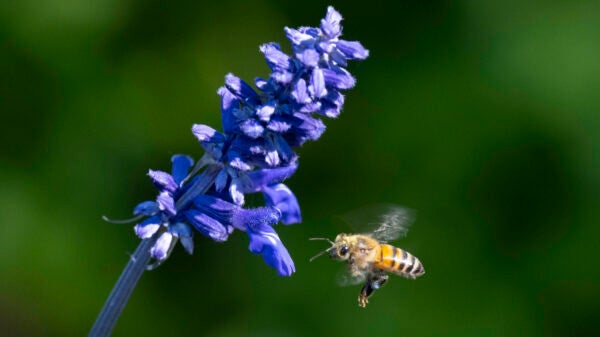
If Texas farmers could make more money by doing less, and if doing less also had the side effect of bringing whole ecosystems back to life, shouldn’t they take that deal?
UT biologist Shalene Jha, who was recently promoted to full professor, says yes. (Shalene rhymes with colony, easy to remember for one of the state’s foremost bee experts.)
As just one example, her work has shown that if cotton farmers let spaces around their fields such as irrigation ditches and roadsides go wild, they can increase their yield by 18%, as well as boost production on their neighbors’ farms. To phrase it differently, they could make $1.18 for every dollar they make now. Why? More bees. Even for crops that are self-pollinating, such as cotton, insect visitation can increase their final production substantially — in the case of cotton, by almost 20% in weight.
Cotton, blueberries, squash and hundreds of other crops rely on pollinators to turn their flowers to fruit. Rewilding field margins can make a dramatic difference not only in the bee population but also in supporting nature’s insect and pest controllers, such as birds and wasps. Her related research on urban gardens has shown that managing more diverse plants in these gardens supports the diversity of highly beneficial insects, comes at no cost to food production, and actually enhances human well-being. Nature is responsive and resilient, she says. We just have to give a little to get a lot in return.
What’s more, the vast majority of bees, especially in Texas, nest underground, so moving toward a no-till style of farming, or merely less frequent tilling, also can have a positive effect, Jha says, beyond the commonly known benefit of conserving topsoil.
Paying attention to landscapes such as farms and cities is crucial if we want to maintain what Jha refers to as “the matrix.” It’s not enough to only set aside parks and wildlife preserves for nature; we must look at the landscapes between those habitat fragments. Are they allowing animals, seeds and pollen to move between them?
“For many decades, there was a belief that these wild habitat fragments were isolated and self-sustaining, and that what was living in between didn’t matter. The reality is that some of the smallest organisms we study in our lab, such as sweat bees the size of a grain of rice, can fly kilometers between these habitat patches,” Jha says. And it matters what is within those kilometers.

Her dissertation investigated the plant and animal biodiversity within coffee farms and tropical forest fragments in southern Mexico, and she has continued to study these systems in the years since. Across these habitat patches, Jha and her researcher team would place mesh bags over flower buds that had yet to open; then, when the flowers opened, they would let a single pollinator visit and then close the bag to let the fruits develop.
Analyzing DNA from those fruits, they calculated some of the first pollen dispersal distances for small bees, “Because we collect fruits from a known maternal tree, we have half the genome. Examining the DNA of the fruit and all potential father trees in the landscape, we can determine paternity and in that process track the pollen contribution of a single tiny pollinator. We found that bees were moving pollen multiple kilometers even though some of them are the size of a grain of rice. It’s just mind-blowing,” she says. “It’s like you or me jogging to LA in a day!”
It’s just mind-blowing. It’s like you or me jogging to L.A. in a day!”
What that showed Jha was that all those distinct habitat patches were connected. “We need to think about what’s happening in between. We as humans are managers of not just the most pristine preserves but of all the spaces in between. Farms and urban areas are important to humans, but their composition also matters to pollinators, plants, birds and beyond. The coffee farms in Mexico were the first places I could quantify the benefit of a permeable matrix and how humans can manage them so that they promote animal dispersal and wide-ranging foraging.”
Testing the DNA of fruit is just one method she uses to analyze “landscape genetics.” “To conserve the biodiversity we have, we need to know how pollinators are moving and colonizing habitat patches, which populations are more inbred than others, what threats they’re facing. We can see the signature of their movement and key demographic processes in their DNA.” Those DNA samples could come from a snippet of a leaf or a microscopic snip from a bee’s toes. This tiny bit of genetic information is enough to piece together how populations of bees are related to one another and what they have experienced over time.
For example, by looking at bumble bee DNA, Jha and her team can determine if all individuals in a landscape are sisters or are closely related, likely born of the same queen, indicating there are few colonies, no matter how numerous the bees. “This wasn’t possible before the advance of molecular techniques. You might see 100 bumblebees and say, ‘This habitat is great! Lots of bee colonies,’ but actually there’s just one.” And as with any organism, a small or inbred population is not as resilient to global change.

Jha’s research in the coffee farms showed her how closely science and policy are tied. Though coffee bushes evolved as understory plants in tropical forests, the trend in agribusiness has been to grow the beans in monocultures and in full sun instead of shade. “It’s a very shortsighted way of thinking about the land because those monoculture farms don’t last. They have massive problems with erosion and nutrient limitation, and the plants don’t thrive. The shade-grown coffee farmers were aware of the benefits they were getting from overstory trees and pollinators. But a key process in documenting the biodiversity within these farms is to communicate this ecological benefit so that farmers can get additional certification.”
For Jha, one of the keys to achieving sustainable agriculture to get the benefits to the farmers. “If you’re getting a price premium on your coffee because it’s Smithsonian-certified bird friendly, you’re going to keep your trees. If you don’t have that incentive, and you’re competing with everybody else, it’s very hard to keep them.
We are hearing from farmers in Texas and across the world that their profit margins are often razor thin, and so if they are managing the land in ways that are positive for the environment, we need to incentivize that. There are many types of certification and tax valuation that we can promote to benefit both the farmer and wildlife.” Jha says that, collaborating with the Texas Parks and Wildlife Department, she and her colleagues have been able to include pollinators as a focal group for wildlife management, so that now, landowners can get the same tax valuation managing for pollinators as they do managing for deer or quail.
The state of bees
Several years ago, alarm bells began sounding about declining bee populations. “Those alarm bells are still ringing, and every piece of data indicates that it’s absolutely still a concern,” Jha says. But the decline is not evenly distributed across species. “There are a few pollinator groups that have shown more dramatic declines, including bumblebees. It is part of our lab’s mission to find out what aspect of recent global-change forces is leading to this decline. When farming practices intensify or cities urbanize, which are the species that disappear first?”
Another concern is pathogens, partially facilitated by human management of bees. By transferring honeybee colonies around the world, humans are partially responsible for spreading bee disease. A few Jha’s students have been documenting the importance of plant diversity and resulting pollinator diversity in diluting the spread of these bee pathogens within urban garden systems.
Another pollinator that Jha’s students have begun to study is the longhorn bee, which of course has become her lab’s mascot and featured on their T-shirts. “It looks sort of like Bevo if you squint,” she says, laughing. (Bee-vo?) “These bees are hilarious because their antennae are so long. There’s a reason they’re called longhorn bees!”
It turns out that they are one of the most important cotton and squash pollinators and have evolved alongside these crops because both are native crops cultivated by indigenous Americans. “We have had a very close relationship with these bees and plants for many centuries, if not longer,” she says.
“It was the indigenous communities that cultivated and propagated squash so that it had larger fruits, but we are only now piecing together that full history. What was it about the domestication of these plants that facilitated pollinator evolution?” Jha says these particular longhorn bees are so closely connected to squash that even if the crops are rotated, the bees come back and find it. And while they pollinate many other plants, these bees only feed their offspring squash pollen.
Teaching Longhorns
During the summer before her sophomore year at Rice, Jha, a Michigan native, got a job as an undergraduate research assistant in the Big Thicket National Preserve in East Texas. Growing up in the Detroit suburbs, it was her first extended experience conducting research outdoors and proved to be the event that opened her future. “It was life changing — working at a field station, collecting data for the first time.”
“There are so many ecoregions in our giant state,” Jha says. “The opportunity to come back to the state where I had fallen in love with biology was one I couldn’t pass up.” That and UT’s “world-class” biology department sealed the deal.
There are so many ecoregions in our giant state. The opportunity to come back to the state where I had fallen in love with biology was one I couldn't pass up.”
Now, she spends part of each summer trying to replicate that life-changing experience for UT students, especially those in demographic categories that historically have not been included in science, such as women and students of color. “These summer research opportunities are such important ways for us to support our students here at UT and beyond. They create some of the first moments students are spending time outside, getting their hands dirty, and collecting data on their own.”
She and her students conduct long-term monitoring at UT’s Lady Bird Johnson Wildflower Center, the Brackenridge Field Lab, and the Stengl Lost Pines Biological Station near Smithville, searching for patterns of pollinator decline and recovery.
Three years ago, Jha cofounded the InSTInCT REU Program (Inclusive Student Training in Collections and field-based Topics) to focus on students who might not have had the opportunity to conduct research — many from communities that are traditionally underrepresented in biology. (REU is a National Science Foundation designation standing for Research Experiences for Undergraduates.) The summer training not only provides field training but also key professional-development activities, demystifying processes such as how to write a statement of purpose or how to apply to graduate school.
During the long term, Jha teaches Introduction to Ecology to about 100 upperclassmen. The graduate course she teaches, Graduate Skills Biology, is focused on professional development, including hypothesis development and grant writing. “A large part of science is communicating your questions, hypotheses, and contributions — this is the course I wish I had taken as a first-year graduate student.”
“One of the reasons I was attracted to UT,” says Jha, “is that I always felt it is a fundamental part of our mission to support the next generation of scientists.”

Did You Know …
- There are about 4,000 bee species in the U.S., and more than 1,200 of them are in Texas. “We happen to be in a global biodiversity hot spot for bees,” Jha says. “Austin alone is home to some 150 bee species. They emerge at different times of the year, and some only forage outside of their nests for a few weeks.”
- Bees are vegans and are the “more evolved” offshoot of wasps, which are carnivores.
- Some bees are “buzz pollinators.” Across the plant kingdom, certain plants need to be buzz-pollinated. Tomatoes are one example. The anthers are shaped like a tube with a tiny hole at the top, and the pollen sits at the bottom of the tube. For the pollen to come out, it has to be vibrated. Just tapping it will not release the pollen; it’s a specific frequency that some bees can generate better than others.
- Only the females of any species sting because the stinger is a modified egg depositor. Most native bees won’t sting unless you’re threatening them or their nest. Jha has been stung only twice in her life, and both times it was from mishandling a bee she was trying to put in a jar.
- While hummingbirds, also important pollinators, respond to bright reds, bees are most responsive to blues and yellows as well as to ultraviolet light.



